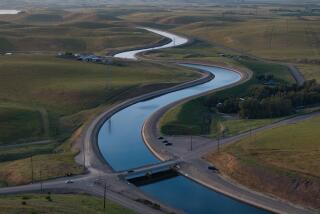Rainfall in North Ends Threat of Water Cuts
SACRAMENTO — Substantial rainfall in key northern watersheds during the first 10 days of December has eliminated the threat of cutbacks in water deliveries next year to municipal and industrial users in Southern California, state officials said Monday.
Heading into the month, officials of the Department of Water Resources expressed concern that unless significant amounts of precipitation fell, customers of the State Water Project could face reductions in their water supplies next year.
However, heavy rain in the important Feather River and upper Sacramento River basins during the first 10 days of the month provided enough water to assure that project contractors, such as the Metropolitan Water District of Southern California, would not suffer cutbacks to municipal and industrial users, they said.
Noting that December is an important month for making calculations of water availability for the next year, the department’s chief hydrologist, Maurice Roos, said he believes that 1988 still may be very dry but it would be nothing like the drought of 1977.
“That week-to-10 days of rainfall, in my view, pulled us out of something like 1977,” Roos said.
Traditionally, the department on Dec. 1 makes its initial estimates of the amount of water that will be available to project contractors in the coming year. As the winter progresses, the estimates are updated to more accurately reflect the volume available for actual delivery to customers.
However, the department and water contractors last month agreed to delay making the initial projection for two weeks. This enabled the department to include predicted Northern California storms in their estimate.
Allocation Increased
“As of Dec. 1, we were looking at 2 million acre-feet (for delivery),” said Dave Hitzeman, acting chief of the water project’s analysis office. “Now we are going to approve 2.25 million acre-feet.”
(An acre-foot usually is considered enough to satisfy the demands of a typical family of four for a year.)
Hitzeman said project contractors had applied for 2.6 million acre-feet, adding that depending on the amount of precipitation during the remainder of the winter there is “90% chance that we will be able to give them their full 2.6 million acre-feet.”
“For the municipal and industrial customers of Southern California, it means no reduction,” Hitzeman said of the new estimates and the initial allocations that will be granted to Water Project contractors.
To assure that deliveries to municipal and industrial users will not be cut back, the department was required to grant agricultural customers only 68% of what they sought. He said, however, that growers, too, probably will receive virtually all the water they sought.
Snowpack Is Thin
Roos noted that most of the precipitation was rain and that relatively little snow fell in the Northern Sierra. He termed the thin snowpack “somewhat less for this time of year, but better than it was last year at this time when we had virtually none.”
As for water storage, Roos estimated that such major reservoirs as Oroville, Shasta and Trinity “are approaching 85% of average,” a slight gain from 82% on Nov. 30. In the last two weeks, he said, these reservoirs have collected an additional 750,000 acre-feet of water, including 176,000 acre-feet at Oroville, a key storage facility of the State Water Project.
Roos said the runoff into the three reservoirs was “pretty significant” and seems certain to increase because “we’ve got 75% of our precipitation year still ahead of us.”
For planning purposes, the department intentionally makes conservative estimates of the availability of water. The department is assuming that from mid-December through the rest of the water year, precipitation will be about what it was in 1977, the last drought year and the driest year on record.
The conservative estimates are designed to avoid making overly optimistic water allocations and then having to impose reductions later in the year.
More to Read
Sign up for Essential California
The most important California stories and recommendations in your inbox every morning.
You may occasionally receive promotional content from the Los Angeles Times.










